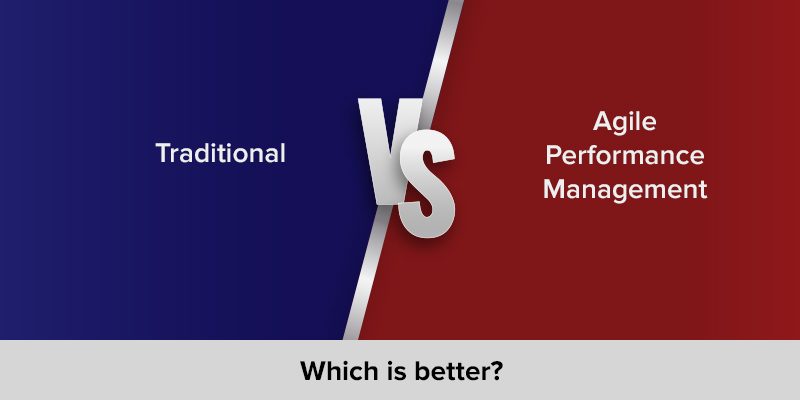Traditional vs Agile Performance Management: Which is better?
In this fast-paced world, businesses are growing rapidly and there are new demands in the market every day. To grow in this fast-paced market, it is important that businesses adopt new strategies to stay ahead. Performance management is one such aspect that companies need to transform to suit the current needs of their business and the requirements of the customers.
Performance management is a strategic business process. It focuses on the performance of the employees keeping in mind the overall development of the organization as such. One might as well define performance management process as a series of activities that ensures that goals are met in an efficient manner and unleash the potential of individual employees or their teams to the maximum. Performance management ensures the overall effectiveness of the organization. It increases business profitability.
Performance management should be such that it is futuristic and such future oriented companies ought to adopt new performance management approaches and replace the conventional ones. An agile performance management system as opposed to a traditional performance management system ensures better employee engagement and business success. This is because, they are timely, accurate and very success oriented.
Before delving deeper into the differences between the two, let us define each of the concepts:
What is Traditional Performance Management?
This is a conventional approach that looks at performance management as the set of activities that examines an employee’s performance over the year. It aims to measure an employee’s performance over the year, at the end of which an employee receives an appraisal letter. Some would define it as an annual appraisal cycle. The performance assessment is usually confined to salary revisions and bonuses. There is minimal room for any kind of progress dialogue to take place.
What is Agile Performance Management?
An agile performance management system could be defined as an overarching process that is very engaging and collaborative in nature. It engages and manages employee performance effectively with a comprehensive continuous feedback mechanism in place. An agile performance management system is usually accompanied with technology in the form of a performance management software. This performance management software usually comes with features that make the performance management process quicker and efficient.
Traditional vs. Agile performance management:
| Traditional Performance Management System | Agile Performance Management System |
| Performance reviews are conducted only once a year. | Performance reviews are conducted on a regular basis. |
| It becomes hard to recall the good performance of an employee because it is not done on a continuous basis. | It is easy to review an employee’s performance because there is a continuous feedback mechanism in place. |
| There is minimal scope for employee growth because there is a lack of proper guidance or developmental plans | There is a lot of room for employees to grow and work on their weaknesses. |
| Communication is only focused on the employee performance and not on overall development. | Communication is constructive and focuses on the business development along with employee growth. |
| Performance appraisals are retrospective in nature | It has a strategic approach as it is very future-oriented and works towards employee career development. |
| Employees often get anxious or withdrawn because it does not address their challenges effectively. | Employees tend to improve their weaknesses as their challenges are addressed properly with intervention and guidance. |
| Employees often struggle or get disgruntled because of a lack of preparation for the annual review cycle. | Employees have enough time to prepare for their appraisals as they are communicated regularly on what is expected out of them. |
| It results in poor employee engagement as employees are often not recognized properly for their good performance and hard work. They feel undervalued. | It results in better employee engagement because employees are rewarded and appreciated on a regular basis for their hard work. |
| Expectations and goals are not communicated clearly, and they are often not aligned with the business objectives. | Goals are defined clearly and are prioritized according to the objectives of the organization. |
| Communication is often linear in terms of being only one-way. It is only top down in terms of the manager giving his feedback to the employee on his performance and convincing him of the results. | When partnered with technology or a PMS software, communication happens on multiple levels and feedback is solicited from multiple sources, including external stakeholders. |
| Employees often have a sense of being dictated to as there is no team work and minimal autonomy is given to employees while performing their tasks. | Increases collaboration as there is regular flow of ideas. Creativity and team development are encouraged, and they have sense of belonging to the company. |
Final words
When it comes to your business, there is no one size that fits all. Both traditional and agile performance management works towards assessing the performance of an employee. While traditional performance management process objectively focuses on employee performance and evaluation the latter chooses to focus on the development of the employee and the organization as well. Ultimately, it is up to the organization to choose what suits their business needs best. But it is also important to keep in mind the current trends in order to place your business in the market.
Related Articles:
- Must-Have Features of Performance Management System
- Major Benefits of Effective Performance Management on the Employee Lifecycle
- How Can Organisations Create a High Performance Management Culture Strategy?
- 15 Ways to Foster and Sustain a High Performance Culture
- Performance Management Outlook For 2023
- Why is Performance Management Important to Small Businesses?


Very informative piece of article, this blog has helped me to understand the concept even better. Keep on blogging.